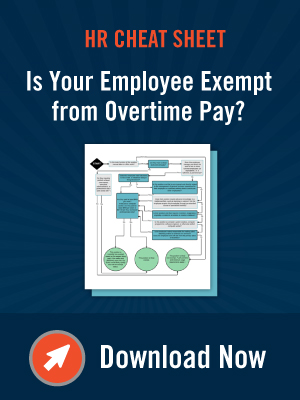Prepare for Changes to the DOL Overtime Proposal

 This past summer most employers were in full ACA mode getting ready for 2016 ACA filing and compliance.But another significant Department of Labor (DOL) proposal was issued that changes overtime exemption for certain salaried workers. The proposed revisions could impact millions of workers and thousands of businesses across the country depending on the final law. There is time to prepare a review and transition plan for those exempt workers who need to be reclassified as non-exempt in order to stay compliant with labor laws by mid-2016 when the subsequent final ruling is expected.
This past summer most employers were in full ACA mode getting ready for 2016 ACA filing and compliance.But another significant Department of Labor (DOL) proposal was issued that changes overtime exemption for certain salaried workers. The proposed revisions could impact millions of workers and thousands of businesses across the country depending on the final law. There is time to prepare a review and transition plan for those exempt workers who need to be reclassified as non-exempt in order to stay compliant with labor laws by mid-2016 when the subsequent final ruling is expected.
The DOL proposed revisions to the Fair Labor Standards Act (FLSA) change both the salary and job duties test to define an employee as exempt. Exempt and nonexempt status refers to an employee’s eligibility for overtime based applying laws for job duties, task performed and the level and form of compensation. These FLSA revisions, generally speaking, are narrowing white-collar exemptions for executive, administrative, professional, computer and outside sales employees, by changing the minimums of the salary test used to determine exempt status.
The Changes
The FLSA proposal raises the minimum salary level for the white collar exemption standard set at the 40th percentile of weekly earnings for full-time, salaried workers. If the rule takes effect in in 2016, the 40th percentile is expected to be approximately $970 per week (rounded to $50,440 annually). This more than doubles the current white collar salary threshold of at least $455 per week ($23,660 annually). There is also a proposed change for highly compensated employees salary from a current minimum of $100,000 to $122,148.
This change in the salary test is expected to affect millions of workers, and it has been noted that publicity of the revision will likely cause employees to have questions about their classification and status. The business community voiced their concerns about the proposed changes with over 250,000 comments submitted during the 90-day comment period, clearly this is something that people are talking about. HR community has concerns as well as noted in a recent SHRM article, “HR professionals attending the Annual Conference were worried about the effect the rule would have on their compensation budgets, which would take a hit from increased overtime pay or increasing salaries so that employees can keep their exempt status.”
Four steps you can take to prepare for changes to the law include:
1. Perform an Employee Audit
Now is a good time for and audit of your exempt status workers to get ahead of the DOL ruling. Some general goals of an employee audit are:
- To understand current compensation spending.
- To define the current mix of exempt/nonexempt employees and the compensation to the new proposed minimum level of $50,444 per year.
- To Identify exempt employees that are close to the new threshold, if the revised FLSA rules become final.
The results of the audit should provide HR with an outline for the the number of employees that will be affected by the new salary threshold, and identify employees that are close to the threshold. This information will be useful to prepare reclassification plans, adjustment to job descriptions, the overall effect on the compensation budget, and current time and labor management procedures.
2. Review Current Timekeeping Practices
It is important to look at your timekeeping processes and revisit time and labor management. A large conversion of employees from exempt to non-exempt status can be a big challenge. Are your employees going to need to clock in outside of an office? How is scheduling to specific hours going to affect shifts? Will time need to be tracked based on cost centers or type of work being performed?
This might be impossible to determine since with an exempt status, it is unlikely that anyone was keeping track of these, but now tracking punches, time worked, cost centers and more are going to be important to stay compliant with labor laws. Advanced knowledge and technology may be needed to stay on top of current wage and hour issues and be able to report on overtime payment, the calculation of the regular rate for overtime purposes, and other issues related to time management.
3. Analyze Labor Costs and Effect on Budgets
In most organizations, employee compensation is the largest annual cost center. According to PricewaterhouseCoopers, labor costs represent 28% of annual revenue for most U.S. companies. With a significant FLSA revision it is no surprise that the compensation was a major concern of HR professionals at the last SHRM annual conference. Rightly so, no matter the breakdown of workforce classification status, there is the same finite amount of resources for compensation. It will be important to understand the balance of work duties and overtime, before simply increasing anyone’s annual compensation.
4. Develop a Communication Plan
Every employer is going to need an extensive communication plan, even if there are little actual effects on the organization. This will be a highly publicized labor change and your employees are going to have questions. For employees that need reclassification, plan for extensive documentation and have training ready for newly classified employees to understand policies and procedures.
For employees that are unaffected by the new laws, be prepared to be able to answer questions and help them understand why they were not included. SHRM provided a great guidelines article for preparing for this transition. See SHRM article here.
Seek Legal Guidance
Due to the breadth, complexity, and volatility of labor regulations, it is also a good idea to obtain legal advice. After the employee analysis is complete, consult with a labor and employment lawyer or attorney. They are experts and can provide legal guidance and consequences of non-compliance penalties when changes to local or federal laws are planned.
Will Your Organization Require a More Sophisticated Time and Labor Solution?
Short of conducting an employee by employee audit, having an understanding of your employee data can uncover perspective on the number of people that are close to or above the new threshold. These revisions are expected to affect millions of workers and it is anticipated that a large percentage of businesses will need to reclassify employees and be prepared for a greater number of employees operating in a more complex time and labor management.
Timekeeping is one of the most difficult and error prone aspects of managing employees. These new labor laws are expected to force companies to reclassify millions of workers, but organizations might not have any systems to actually handle the increased time tracking requirements or manage the effects on payroll and compliance after being accustomed to exempt employee status.
Time tracking errors are costly the same PricewaterhouseCoopers study found that errors associated with non-automated labor management processes can cost an average company 1-3% of those labor dollars. Without the proper time and labor management during a reclassification companies might see a jump in cost related to errors, but also run the risk of Non-compliance which leads to regulatory penalties. According to the U.S. Department of Labor, seven out of 10 companies are not compliant with wage and labor laws. In 2013 alone, U.S. businesses spent an average of $4.5 million to settle wage and hour disputes — fines that are significant enough to cripple a small or mid-sized business.
The cost savings from accurate time tracking can produce a positive ROI in the short term. Staying compliant with labor laws to avoid penalties and lawsuits can provide additional peace of mind for any business or organization. In the coming months leading to the final release of the exempt employee revisions, investigate solutions to manage time and labor. Organizations of any size can realize significant savings by more accurate employee time management. In general, how would your business benefit by recouping 1-3% of total payroll costs each year?
OnePoint Human Capital Management's powerful HCM solutions can help your organization do just that: Manage your workforce more efficiently and effectively, control costs and stay compliant. Contact OnePoint HCM to discuss automating and streamlining time and labor management strategy.
Subscribe to updates
Get the latest posts delivered to your inbox.